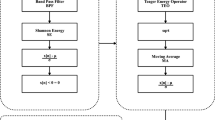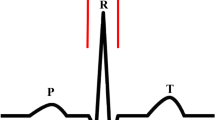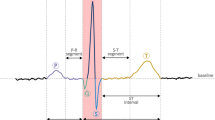Abstract
Electrocardiogram (ECG) is an economic, convenient, and non-invasive detecting tool in myocardial ischemia (MI), and its clinical appearance is mainly exhibited by the changes in ST–T complex. Recently, QRS complex characters were proposed to analyze MI by more and more researchers. In this paper, various QRS complex characters were extracted in ECG signals, and their relationship was analyzed systematically. As a result, these characters were divided into two groups, and there existed good relationship among them for each group, while the poor relationship between the groups. Then these QRS complex characters were applied for statistical analysis on MI, and five characters had significant differences after ECG recording verification, which were: QRS upward and downward slopes, transient heart rate, angle R and angle Q. On the other hand, these QRS complex characters were analyzed in frequency domain. Experimental results showed that the frequency features of RR interval series (Heart Rate Variability, HRV), and QRS barycenter sequence had significant differences between MI states and normal states. Moreover, QRS barycenter sequence performed better.




Similar content being viewed by others
References
Langner PH (1952) Value of high fidelity electro-cardiography using the cathode ray oscillography and an expand time scale. Circulation 5:249
Roger P, Harold B (1976) The QRS complex during myocardial ischemia—an experimental analysis in the porcine heart. J Clin Investig 57:541–550
D Ollnic, N Olinic, J Machecourt et al. (1995) High-frequency QRS components in coronary heart disease: relation to coronary angiography, left ventriculography and myocardial scintigraphy. Comput Cardiol 261–264
Pettersson J, Pahlm O, Carro E et al (2000) Changes in high-frequency QRS components are more sensitive than ST-segment deviation for detecting acute coronary artery occlusion. J Am Coll Cardiol 36(6):1827–1834
Weston P, Johanson P, Schwartz LM et al (2007) The value of both ST-segment and QRS complex changes during acute coronary occlusion for prediction of reperfusion-induced myocardial salvage in a canine model. J Cardiol 2007 40(1):18–25
Toledo E (2007) HyperQ: a novel technique for detecting stress-induced ischemia using analysis of the electrocardiographic depolarization phase. J Electrocardiol 40:S71–S74
Pamela K, Niles J, Evans RT et al (2006) Temporal and postural variation of 12-lead high-frequency QRS electrocardiographic signals in asymptomatic individuals. J Electrocardiol 39:259–265
Ringborn M, Pettersson J, Persson E et al (2010) Comparison of high-frequency QRS components and ST-segment elevation to detect and quantify acute myocardial ischemia. J Electrocardiol 43:113–120
Tsukahara K, Kimura K, Kosuge M et al (2005) Clinical implications of intermediate QRS prolongation in the absence of bundle-branch block in patients with ST-segment-elevation acute myocardial infarction. Circulation J 69:29–34
Murat M, Karadede A, Aydinalp O et al (2004) The relationship between terminal QRS complex distortion and early low dose dobutamine stress echocardiography in acute anterior myocardial infarction. Jpn Heart J 45:373–386
Arend FL, Elhendy A, Ron T et al (2009) Prognostic significance of QRS duration in patients with suspected coronary artery disease referred for noninvasive evaluation of myocardial ischemia. Am J Cardiol 104:1490–1493
Nakamura N, Gohda M, Satani O et al (2008) Myocardial salvage for ST-elevation myocardial infarction with terminal QRS distortion and restoration of brisk epicardial coronary flow. Heart Vessel 24(2):96–102
Pueyo E, Sornmo L, Laguna P et al (2008) QRS slopes for detection and characterization of myocardial ischemia. IEEE Trans Biomed Eng 55(2):468–477
Romero D, Ringborn M, Laguna P et al (2011) Depolarization changes during acute myocardial ischemia by evaluation of QRS slopes: standard lead and vectorial approach. IEEE Trans Biomed Eng 58(1):110–120
Huali Z, Pingsheng W (2008) Significance of a fragmented QRS complex in myocardial ischemia of coronary artery disease. Southern Medical University, Guangzhou
Xin G, Peng Yi, Jianlong Z et al (2008) Effect of ischemia-reperfusion on combined data of QRS complex waves of electrocardiogram and myocardial enzymes in rabbits. Chin J Rehabil Theory Pract 14(4):316–318
Jager F, Taddei A, Moody GB et al (2003) Long-term ST database: a reference for the development and evaluation of automated ischaemia detectors and for the study of the dynamics of myocardial ishcaemia [J]. Med Biol Eng Comput 41:171–181
Song J, Yan H et al (2010) Research on electrocardiogram baseline wandering correction based on wavelet transform, QRS barycenter fitting, and regional method. Australas Phys Eng Sci Med 10:33–37
Wang X, Peng Y (2007) Heart rate variability analysis on ECG ST-segment deviation eposodes based on the time-frequency method [D]. Peking Union Medical College, Beijing, pp 1–28
Acknowledgment
This study was supported in part by Research Funds of China space medical engineering (SJ201006).
Author information
Authors and Affiliations
Corresponding author
Rights and permissions
About this article
Cite this article
Song, J., Yan, H., Xu, Z. et al. Myocardial ischemia analysis based on electrocardiogram QRS complex. Australas Phys Eng Sci Med 34, 515–521 (2011). https://doi.org/10.1007/s13246-011-0099-8
Received:
Accepted:
Published:
Issue Date:
DOI: https://doi.org/10.1007/s13246-011-0099-8




